You may need to quickly knit socks on two knitting needles when you don’t want to waste time on circular knitting of socks. This is a good option for home shoes, which maintains the desired temperature of the feet and is suitable for wearing with boots, shoes or other footwear. This product is made without seams or from 2 parts, which are then sewn together.
Necessary tools and materials
You can quickly knit socks using a ready-made pattern and suitable tools. Their choice may depend on the model of the product. To create warm socks on two knitting needles, use yarn with wool in the composition, for a decorative product - threads with the addition of acrylic or shiny threads.
It is important that the threads are not too prickly, otherwise the product will be uncomfortable to wear. Therefore, preference is given to blended yarn, which contains elastic threads.
If the task of the product is not to retain heat, but to perform a decorative function, then the choice of yarn is wider:
- wool;
- silk;
- melange;
- cashmere;
- cotton or linen;
- home;
- angora;
- mohair;
- boucle, etc.

To calculate the required amount of yarn, pay attention to the indicator on the packaging - "conditional thickness". It indicates how many meters of thread are in 1 skein or in 100 g of yarn. The longer the thread, the thinner the thread of yarn and the greater its consumption.
The average figure is considered to be 300 m per 100 g. It is recommended for beginner knitters to work with such yarn.
Knitting needles are selected for a specific type of work. It is recommended to choose straight knitting needles No. 2-3 if you are going to make footies according to a pattern where the fragments will need to be sewn together at the end of the work process. If you choose the method of knitting with a single piece of fabric, then you work with circular knitting needles with a fishing line or a cord of medium length. Stocking knitting needles are also suitable.
Experienced craftswomen rely on their experience when choosing tools, but if they are starting work for the first time, they follow the recommendations specified in the master class description. Most often, they adhere to the general rule for selecting knitting needles, where their number should be 1 unit larger than the yarn number (knitting needle No. 3 is suitable for yarn with a thickness of 2 mm).
Such recommendations are often left by manufacturers on the yarn packaging.
Also, when choosing knitting needles, pay attention to their composition and length. Medium-length knitting needles are suitable for knitting socks, stockings and footsies. Metal knitting needles slide well on wool and acrylic, and also last a long time.
Plastic needles are also convenient for this work, especially due to their light weight. If you have little experience in knitting, then choose bamboo or wooden needles - they hold the loops better and do not allow them to stretch.
Schemes with descriptions for beginners
You can quickly knit socks on two knitting needles by mastering the classic patterns for making socks or socks, since most of the methods are similar to each other. The main difference between them is how well the product fits the foot.
They also have fewer seams when assembling the product or can be made without seams at all. The simplest socks are made on 2 knitting needles, following the instructions below.
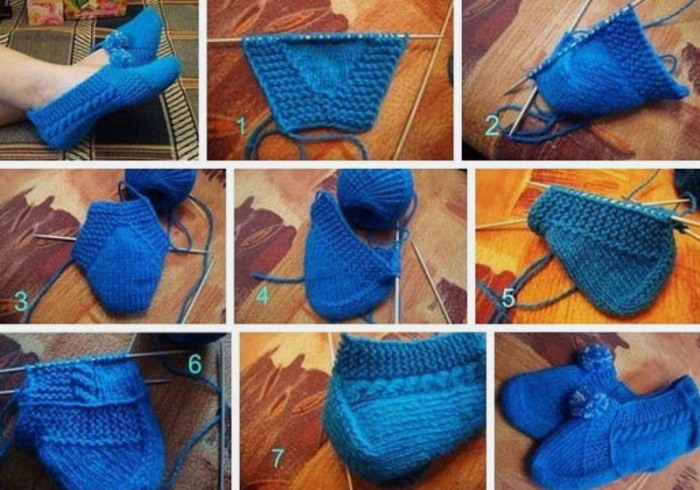
Socks with a braid in the center
The socks with a turn-up and a braid pattern are knitted in stages - first, the desired height is gained, then the heel is knitted and finally the parts are sewn together.
The order of production of the product is as follows:
- For the sole, calculate the required number of loops in a row, equal to the length of the foot. In this example, make a set of 41 loops with the main yarn threads. Perform 5 rows of garter stitch.
- Add the second color of thread to the main one and continue knitting. Make 1 loop with a secondary color, 2 - remove behind the fabric and repeat the alternation up to the 21st loop.
- 21st loop: knit 9 loops from it in turn - front, yarn over. Work with the remaining loops as in step 2.
- In the next row (purl), remove the loops of the main color and hold the thread in front of the fabric. The threads of the additional color are knitted as faces.
- Repeat steps 2-4 (7 times).
- When you have reached the desired height of the sock, select 13 loops in the center. Knit them in the main color of the garter stitch.
- For the sole, make 1 row, knit the end loop and side sections together. Turn the working fabric over and knit the row, end loop and side sections again. Continue this algorithm further.
- When only 13 loops remain on the sole, form the heel: knit the remaining loops. At the end of the row, connect at the outer loop in the row and in height.
- The footstool is sewn at the back according to the height of the footstool.
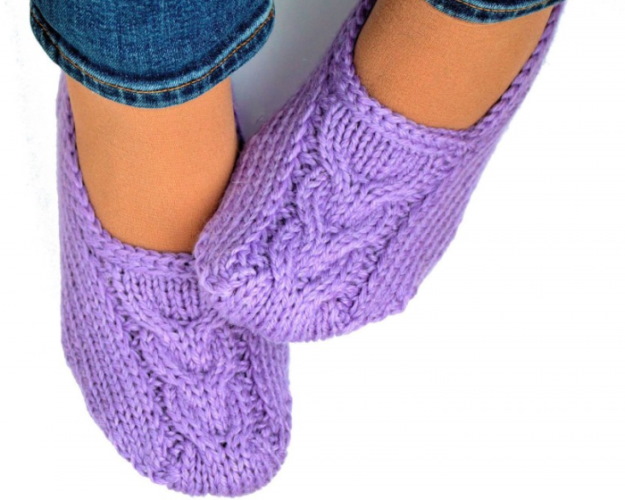
Star Pattern Footprints
You can quickly knit slippers on two knitting needles by choosing any pattern. In this example, acrylic threads (200 m per 100 g) and knitting needles No. 3.5 were used for slippers of size 38.
For this foot length, cast on 59 loops - this amount is enough to form the pattern. If you plan to make a larger or smaller size product, calculate the number of loops according to your measurements.
For the sole, knit 4 rows of classic elastic (1*1). The pattern is formed from 29 loops of each row. In all front rows, on the 30th loop, make an addition: from 1 loop, knit a front, yarn over and front. Every 4 rows, the color of the threads is changed.
In the diagram description, all elements are designated by initial letters for ease of reading (front - L, slip - S, side - B, purl - I). At the end, the sole is knitted from the central 15 loops, then the heel is rounded and the 2 parts are sewn together.
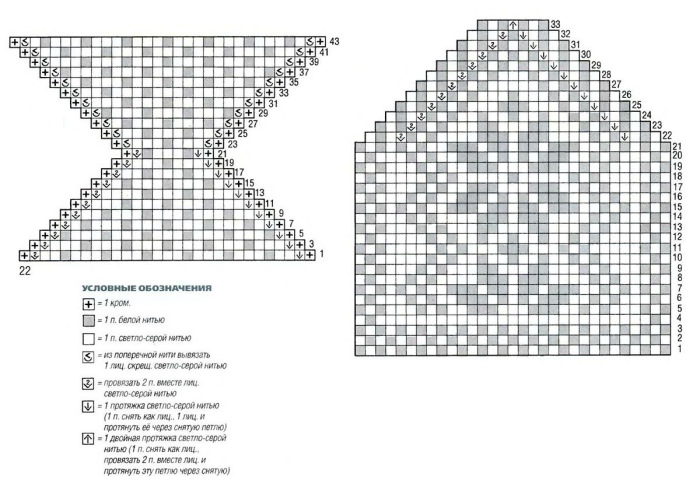
| Row (yarn color) | Description |
| 1 (main) | B, *3L, 1C behind the canvas* (*repeat to the end), 3L, B. |
| 2 (main) | B, *3I, 1C in front of the canvas* (*repeat to the end), B. |
| 3 (main) | B, *3L, 1C behind the canvas* (*repeat to the end), B. |
| 4 (main) | B, *3L, 1C as I* (*repeat to the end), B. |
| 5 (additional) | B, 1L, *1C behind the canvas, 3L* (*repeat to the end), B. |
| 6 (additional) | B, 1I, 1C in front of the canvas, 3I, *1C in front of the canvas, 3I* (*repeat to the end), B. |
| 7 (additional) | B, 1L, 1C behind the canvas, 3L, *1C behind the canvas, 3L* (*repeat to the end), B. |
| 8 (additional) | B, 1L, *1C as I, 3L* (*repeat to the end), B. |
Footprints with garter stitch
A variant of knitting socks with the front method. In the process, the remains of yarn with natural wool fibers in the composition are used so that the product is warm and fits the leg better.
In this example, 30 loops are cast on for a size 37 foot. If you plan to make a product of a different size, cast on the number of loops according to your measurements. Knitting occurs from the bottom up to the ankle, so repeat the rows until the pattern is completed. The remaining loops are closed.
In the diagram description, all elements are marked with initial letters for ease of reading (front - L, back - I, 3 loops together front - 3ВЛ). Front surface is knitted in the classic way.
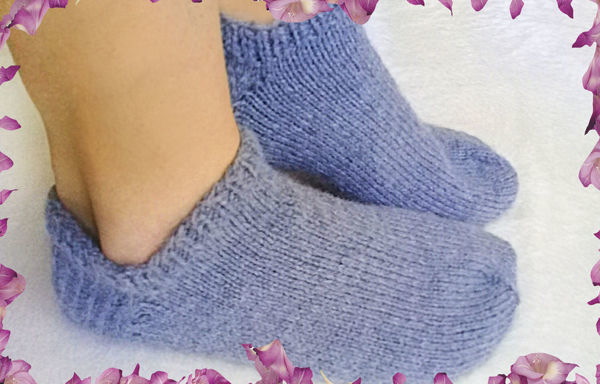
| Row | Description |
| 1-6 | All L |
| 7-22 | Front stitch. |
| 23-41 (form the heel) | 19L, 20-21 knit L, turn the fabric over. 9I, 10-11 tie I, turn the fabric over. 9L, 10-11 knit L, turn the fabric over. Alternate rows until there are 10 loops left. |
| 42 | Cast on 10 stitches from the side heel piece and turn the fabric over. |
| 43 | 20L, from the other side section, cast on another 10 loops. |
| 44-74 | Front stitch. |
| 75 | 7L, 3VL, 10L, 3VL, 7L. |
| 76, 78, 80, 82 | All I. |
| 77 | 6L, 3VL, 8L, 3VL, 6L. |
| 79 | 5L, 3VL, 6L, 3VL, 5L. |
| 81 | 4L, 3VL, 4L, 3VL, 4L. |
| 83 | 3L, 3VL, 2VL, 3VL, 3L. |
| 84, 86 | 9And, the 10th loop is knitted from the braid (there should be 18 loops in total on each side). |
| 85, 87 | 4L, 3VL, 3L, 4th loop from the braid. |
Seamless soles
You can quickly knit socks on two knitting needles without connecting the elements in the center. This method is suitable when you do not like to feel the connecting seam of the socks with your feet. For socks of size 37-38, cast on 27 loops.
In the diagram description, all elements are marked with initial letters for ease of reading (front - L, back - I, slip - S). It is recommended to put markers before switching to another type of loop in a row, so as not to get confused in the pattern.
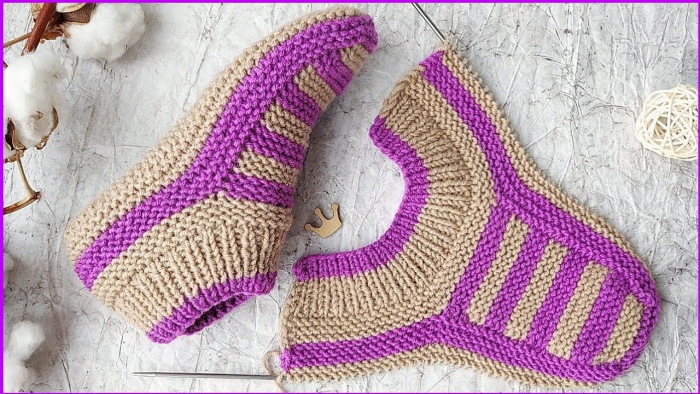
| Row | Description |
| 1, 3, 5 | All L, 5I at the end |
| 2, 4, 6-25 | All And |
| 26 | 1C, all I |
| 27, 29 | All L, 5I at the end |
| 28, 30 | All And |
| 31 | close 11 loops, 1C, 11L, 5I |
| 32, 34, 36, 38, 40 | All And |
| 33 | Close 1st loop, 10L, 5I |
| 35, 37, 39 | 1C, 10L, 5I |
At the final stage, stitch the loops with an invisible seam with open loops and tighten the toe. If desired, the product is processed with a crochet hook with single crochets or the slippers are decorated with bomboshki, etc.
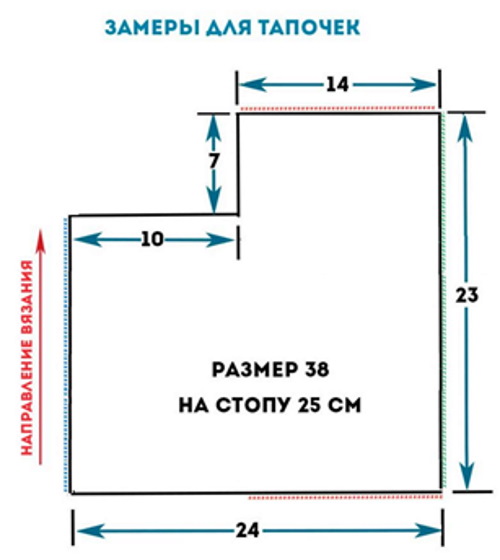
The easiest option
The simplest option for knitting footies on 2 knitting needles, since the process does not use elements of decreasing or increasing loops. In the example, the footies are made with a simple pattern, but it can be omitted and made in a single color.
If you use yarn of 2 colors, then choose shades that stand out against each other. In the process, make a semicircular cloth with garter stitch with a pattern in the form of rows of different lengths.

For medium-length socks, use about 250 g of thread and straight knitting needles (No. 3-3.5). For convenience, also use a pin or other marker. For final work, use a sewing needle.
| Row | Description |
| 1, 2 | 25 loops - main thread color |
| 3 | 20 sts - additional color, turn the fabric over and knit the next row |
| 5, 6 | 25 p. - main color |
| 7 | 15 sts - additional, turn the fabric, knit the 8th row |
| 9, 10 | 25 p. - main color |
| 11 | 10 sts - additional, turn the fabric, knit the 12th row |
| 13, 14 | 25 p. - main color |
| 15 | 15 sts - additional color, turn the fabric, knit the 16th row |
| 17, 18 | 25 p. - main color |
| 19 | 20 sts - additional color, turn the fabric, knit the 20th row |
Then repeat the pattern from the 5th row to gain the required volume of the product (instep). When finished, fold the foot in half, mark the middle of the outer part of the semicircle and mark it with a marker. In this part, both halves are sewn together with the heel using a classic knitted seam.
Baby footprints
Footies are also knitted for children, including newborns, to maintain the required body temperature. Such a product can be made faster on 2 knitting needles. To accurately determine the required size, the child's foot is measured.
In the example, 18 stitches are cast on for a product that will require about 200 g of yarn. Work with 2 straight knitting needles (No. 3) and a crochet hook (No. 2). In the process, also use a marker pin or switch to circular knitting needles so that your hands do not get tired.
- Perform 60 rows in garter stitch. Close all loops with knit stitches.
- From the side section, cast on 32 loops.
- Knit a circular fabric of 15-25 rows. Perform this stage with the same pattern or any other as desired.
- Decreases stitches to form the toe of the garment: 1 knit, 2 knits in 1, 10 knits, 2 knits in 1, 1 knit (repeat until there are 8 stitches on the needles).
- Pass the working thread through the remaining loops, tighten and secure.
- Both parts from the heel are connected with a knitted seam.
- If desired, the product can be crocheted and decorated with knitted patterns and elements.
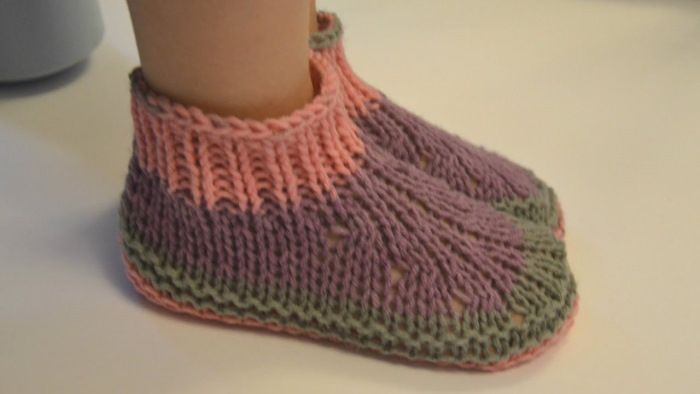
With a beautiful pattern
You can quickly knit socks on two knitting needles using different patterns to give the product a more elegant look. A simple pattern in the form of braids in the center of the socks is done on 2 knitting needles. It is easy to do and is suitable for beginner knitters.
The example uses yarn of 2 colors, but if desired, you can use 1 color or add more threads.
For size 37-38 socks, cast on 17 loops and use half a skein of 2 different colors.
In the diagram description, all elements are designated by initial letters for ease of reading (garter stitch - P, yarn over - N, front stitch - L, back stitch - I).
| Row | Description |
| 1 (color A) | 8P, N, L, N, 8P |
| 2 and all even (color A) | According to the pattern (garter stitches and purl stitches, as in the previous row). Cast on 8 stitches from both ends until you have 33 stitches on the needles. |
| Add a thread of the 2nd color (the skeins are led from different sides of the working fabric), the threads are crossed. | 8P (color B), 8L (color A), H, L, H, 8L, 8P (color B) |
| Even rows | According to the picture. 8 loops on both sides are made in a secondary color.
Cast on 8 stitches on both sides until there are 49 stitches on the needles. |
| Both threads | 16P (color A), 8L (color B), H, 1L, H, 8L, 16P (color A).
Cast on 8 stitches on both sides until there are 65 stitches on the needles. |
| Both threads | 24P (color A), 8L (color B), H, 1L, H, 8L, 24P (color A).
Cast on 8 stitches on both sides until there are 81 stitches on the needles. |
| Color B | Knit the central 17 loops. |
| Both colors | 24P (color A), 24L (color B), 2 together L, turn the canvas.
16And, 2 together And, turn the canvas. 16L, 2 together L, turn the web. Repeat the algorithm until you have knitted all the loops from the outer 2 knitting needles. |
| Both colors | The loops are picked up from the outer sections and knitted in a single pattern to the heel.
Knit the heel like a sock. |
Secrets
To ensure that the tracks are of higher quality, follow the advice and recommendations on the work process.
- Carefully read the diagram at the beginning of the work and all the symbols so that you don’t have to unravel the product.
- Footies fit well if you take precise measurements from your foot and calculate the loops based on them. Footies that are too big will slide off your heel.
- Openwork footies are made with large knitting needles (from 4.5), dense footies - with smaller knitting needles.
- The edges of the socks are crocheted to prevent stretching.
- To make the soles of the socks last longer, they are knitted in 2 threads, and a synthetic thread is added to the heel. Sock yarn is also used. Insoles sewn to the sole help extend the service life.
- The ribbed pattern on the sole creates a massage effect.
- If the thread on circular knitting needles is too tight and inflexible, soften it by holding it in boiling water.
- Sew ribbons on the sides of the socks, quickly knitted on two knitting needles, so that they stay on the foot better.
Video on how to knit socks with knitting needles
This video shows how to knit Knitting needles footprints. Detailed master class. Easy and simple. Even a beginner knitter can knit it.
